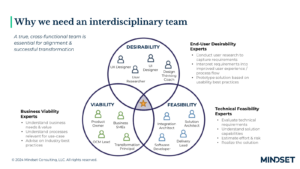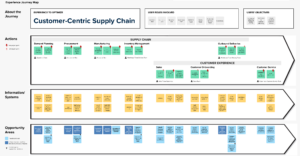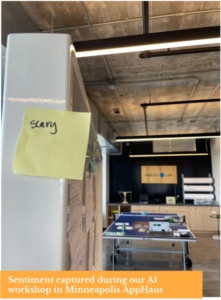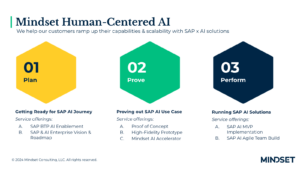“Right now what we’re seeing is that humans are collaborating with these models. And the outputs are mostly hybrid. This part will continue for a while where we collaborate with these models and they amplify our cognitive abilities, our creativity.” – Mira Murati
The brilliant mind behind ChatGPT and former CTO of OpenAI, Mira Murati, played a pivotal role in major advancements at the company. Her quote above emphasizes the collaborative interplay between humans and AI models, highlighting how AI serves to enhance human capabilities, rather than to replace them.
At Mindset, we believe that human-centered AI, when paired with ERP software like SAP– touching 77% of the world’s transaction revenue– has the potential to transform business interactions. Our AI Workshop Series with SAP explored 149 use cases and emerging patterns, outlined in our first article. Our second article focuses on common business challenges across Customer Experience, Finance, Supply Chain, and IT, highlighting how AI is changing the way organizations work by enabling the combination of technological capabilities that were once unattainable, leading to more impactful business outcomes.
This final article in the series will dive into the implications for organizations looking to implement AI and drive their business transformation. We’ll highlight key considerations and Mindset’s systematic approach—Plan, Prove, and Perform—to help enterprises achieve their strategic ambitions with AI and SAP technologies. But first, we’ll outline some key observations.
Key Insights from the Workshops
1. Efficiency Gains Are Top of Mind, but Market Gains Matter, Too
A recurring theme in the workshops was the drive for efficiency. Participants were primarily focused on automating repetitive tasks and reducing costs. From financial processes like invoice processing to customer service automation, AI is seen as a tool to streamline operations.
There was a realization though, that AI can also be a powerful driver for market growth. Participants acknowledged that to realize the full potential of AI, businesses need to strike a balance between addressing today’s challenges and preparing for those of tomorrow, i.e., automating routine tasks vs. creating new value propositions. This requires a paradigm shift towards exploring AI’s ability to enable new business model opportunities and create customer experiences that delight, ultimately improving enterprise productivity and financial health.
However, with most organizations having silo’ed perspectives and ways of working, such transformation endeavors require input from various stakeholders within—and even beyond—a company’s ecosystem.
2. The Need for Cross-Disciplinary Collaboration
A notable observation from the workshops was the importance of collaboration between business and IT teams. 85% of the workshop participants were from IT, with the remaining 15% representing business functions. While IT professionals could identify broad use cases for AI, the absence of business stakeholders was felt through the limited depth of functional expertise and validation of solution ideas.
For AI initiatives to succeed, it is no secret that both business and IT teams really need to work together from the outset. Human-centered AI requires an understanding of not just the technical capabilities of AI, but also the business challenges and needs of its people. Figure 1 shows how and why interdisciplinary teams are necessary to get to the sweet spot of innovation – it’s the coming together of different minds that contribute to a holistic perspective of solving a challenge and not succumbing to potential blind spots. This requires transformation initiatives to be orchestrated at the intersection of human-centered design principles:
- Desirability – will the solution address people’s needs?
- Feasibility – can we make the solution a reality?
- Viability – will the solution yield the value we sought to achieve?

3. Not All Use Cases Necessitate AI
While the workshop generated a wide range of AI use cases, not all challenges identified by participants required the application of AI, whether Generative or Traditional/Narrow AI. In some cases, existing SAP solutions such as SAP Analytics Cloud or SAP Datasphere could address the needs without introducing AI. This insight is critical for businesses seeking to solve their immediate challenges in a cost-effective and pragmatic way. Additionally, deploying AI simply for the sake of it may not be the best use of resources. Instead, it is crucial to ensure that AI is a good fit based on a thorough understanding of the friction areas within a business and, more importantly, the needs of the people involved.
4. AI Use Cases Are Often Interconnected Across Business Functions
Another interesting observation was the interconnectivity of AI use cases across different business functions. For instance, AI-driven solutions in supply chain management, such as order tracking and inventory optimization, also had applications in customer experience and finance. This interconnectedness highlights the need for a holistic approach to AI adoption, where use cases are prioritized and sequenced in alignment with the overall business vision, strategy, and experience journey of both customers and employees. Figure 2 illustrates an example of such an instance pertaining to customer-centric supply chain.


5. Overcoming AI Skepticism and Embracing Future-Readiness
While excitement around AI is palpable, skepticism remains a barrier for many organizations. Approximately one-third of participants expressed concerns about the potential risks of AI, such as its impact on jobs or the fear of technology outpacing human capabilities. This skepticism is valid and natural, but it should not halt progress, whether big or small.
Mindset emphasizes the importance of preparing organizations for AI by two means:
- Awareness and education on the capabilities and limitations of AI, case studies, as well as SAP’s strategy, SAP Business AI, and SAP’s co-pilot solution, Joule, and its interplay with SAP S/4HANA
- Building a robust technological foundation, particularly around data management and governance. In the case of companies running SAP, this means taking advantage of the capabilities and flexibility afforded by SAP Business Technology Platform through integration, extension and analytics.
As such, with the right-level of awareness and infrastructure in place, businesses can confidently embrace AI as part of their transformation strategy and vision.
The Path Forward: Embracing Human-Centered AI
As AI continues to evolve, businesses must prioritize not just technology adoption but also the experiences of their employees, customers, and stakeholders. With SAP’s suite of AI solutions and Mindset’s expertise in human-centered innovation, companies can embark on their AI journey with confidence, knowing that they are not just implementing new technologies, but creating meaningful, impactful change for the people who matter most.

Mindset’s Human-Centered AI approach of Plan, Prove, and Perform, helps enterprises progress with their business transformation through AI with SAP, shaping operations with better efficiency and delivering sustainable growth:
- Plan: SAP customers looking to embark on their AI journey would need to ensure that the plan is in place, including the right system setup, governance, and skilled resources are in place, along with a strategic vision & roadmap to realize tangible results.
- Prove: Companies looking to prove out use cases must ensure that the ideas are explored, designed and built with the right stakeholders and the right AI solutions, which can be validated via a Proof of Concept (PoC) or high-fidelity prototypes.
- Perform: Once those concepts are validated, companies can run a Minimum Viable Product (MVP) in their live environment to further test and iterate based on user feedback. As these solutions will impact end-users and pertinent stakeholders, organizational change management will become increasingly important, as will the agility to further roll out various SAP AI solutions.
Download our full report here for more details on our approach and to learn more about use cases that apply to your organization.
Ready to Transform with Human-Centered AI?
At Mindset, we help SAP customers harness the power of AI to drive meaningful business outcomes. Whether you’re just starting your AI journey or looking to scale your initiatives, our human-centered approach ensures that technology works for your people and your goals.
Contact us today to discuss areas of friction that would require a quick fix or a deeper introspection on how your business processes are designed. We would love to explore with you how human-centered AI could apply to your business and discuss the necessary steps to maximize your SAP investments and ensure sustainable productivity for your people and your business.